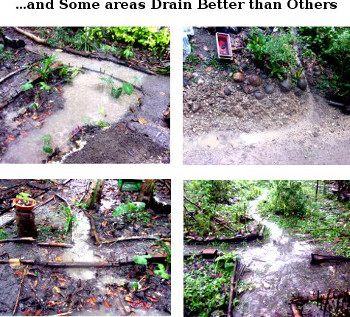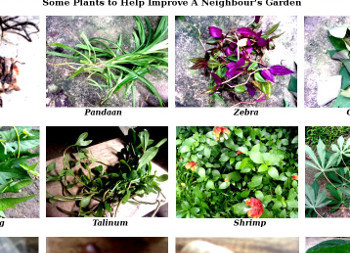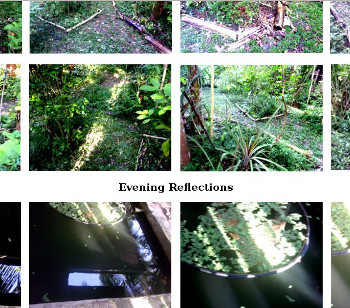


January February March
Notes on 2018:
Consolidation:
The use of garden weeds and trimmings as fodder for the animals (particularly pigs) had proved successful -and is continuing.
As a result, the garden is much less like a jungle over-run by weeds and more like the "edible jungle" that I'm aiming for.
However, there is still a long way to go (see December Diary).
Animals:
The new pig pens have been a success -and taking care of the animals seems to be settling down to a routine affair.
The Ducks and Chickens more or less look after themselves (with some extra feeding) -but can be a nuisance in the garden by damaging plants.
Plants:
The number of crops being grown in the garden does seem to be increasing -both in the variety of crop and the number of viable plants per crop. However, the actual harvest is still very small -and mostly used for reseeding and propagating existing plants.
The use of both rotting leaves and compost from the pig pens is increasing soil fertility -but there is still a lot of room for improvement.
There is still quite a lot of damage from chickens and ducks -although this varies -partly dependent on the population (and the presence of young chicks and ducklings). It is probably better to minimize the damage as much as possible -and continue to profit from the advantages of free range ducks and chickens (fertilizer and pest control) -than to accept the increased (localized) devastation of putting them in fenced areas. We prefer to fence the animals (including piglets) off the crops -rather than fencing these animals in. Unfortunately, we do not have the space for free-range pigs.
Some work has been done on improving the following -but more work needs to be done:
- Planting beans in ways that allow them to climb, without too much excess growth.
- The Protection of seeds and young seedlings from Chickens and ducks has been helped by the use of plastic screens and "mini-greenhouses" creating protected areas -but more work needs to be done in creating more natural protection (including planting seeds amongst weeds to give protection from chickens)
- The use of "wild" areas for hardy plants such as beans, Saluyot, etc could be developed more...
The main project will be tree cutting: Both Mahogany trees for timber (to help a friend repair their house) and coconut trees that will be used as stumps and borders for garden patches. Some trees, such as unproductive Mango trees will be trimmed, if not removed.
We have far too many coconut trees: The price of copra often goes so low that coconuts are not a viable economic crop. They also use up water and nutrients from the soil -and the danger (and damage) from falling coconuts can be quite serious.
So we would like to replant the coconuts with more useful fruit and forage trees. This way we hope to let more light into the garden too.
In a sense, the removal and trimming of (unwanted) trees is merely a continuation of the "consolidation" started earlier.
Our general strategy for trees is to have many trees planted in a small area -but to keep them small and well trimmed (as much as possible without affecting their fruiting capabilities).
The drainage problem seems to have been reduced -thanks to rain gardens, drainage canals and an increase of grass on the paths.
Basically, next year will probably be a continuation of this year:
- Cultivating the areas damaged by the construction of pens and wall (particularly mahogany area)
- Cultivating the areas reclaimed from the old pig and goat pens
- Encouraging the spread of plants where some are already growing
- Continue improving soil (manure and leaf mulch)
- Growing more animal forage
- More decorative plants
- More fruit trees
Assuming the animals continue to e routine, the work for next year falls into two categories:
- Improving the Cultivated Areas
- Developing the "Neglected" Areas (including tree cutting)
As well as Increasing the domestic production of animal foodstuff (reducing our dependence on commercial foods)
-----------